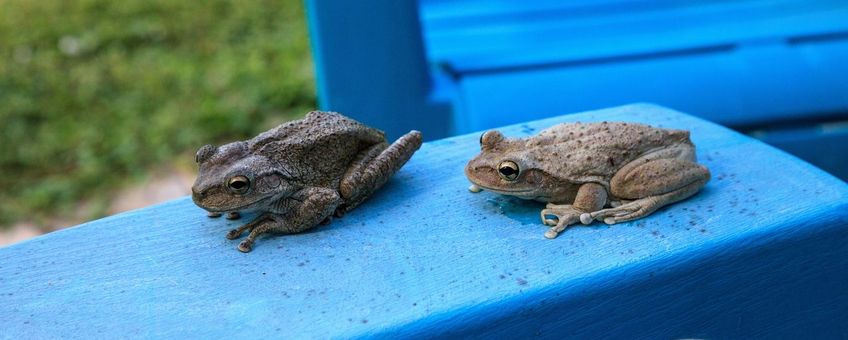
A big frog on a small island: how the Cuban Treefrog invaded St. Eustatius
Wageningen Marine ResearchThe Cuban Treefrog is native to Cuba, the Bahamas and the Cayman Islands, and is known across the Caribbean for its toxicity, loud calls, and ability to outcompete native species. Its establishment on St. Eustatius is therefore cause for concern.
Discovery and origin

In January and February 2025, staff of the St. Eustatius National Parks Foundation (STENAPA) discovered several Cuban Treefrogs (Osteopilus septentrionalis) in a garden adjacent to a recently built resort. Subsequent surveys revealed both adult and juvenile frogs, indicating that the species is breeding locally.
After STENAPA shared the finding on social media, a resident reported that as early as 2022, the first frog had been seen in a shipment of ornamental palms imported from Florida, a well-known hotspot for this species. All evidence suggests that multiple frogs were unintentionally introduced with these plants and have been breeding for several seasons, resulting in an established population now spreading into nearby gardens.
"When we first found the frogs, we immediately realised how serious this could be", said biologist Julian Thibaudier, who conducted the research during an internship at Wageningen Marine Research in collaboration with STENAPA. “The Cuban Treefrog is notorious for spreading rapidly and displacing native species.”
Why this species is a problem
The Cuban Treefrog can grow up to 12 centimeters, reproduces rapidly and preys on almost any animal small enough to fit in its mouth. Although its diet mainly consists of insects, it also eats small lizards and even birds. The species secretes a skin toxin that can harm native predators and irritate human skin. Elsewhere in the Caribbean, its arrival has impacted native frogs and lizards populations. St. Eustatius harbors several unique species, including one of the last populations of the critically endangered Lesser Antillean Iguana (Iguana delicatissima). Therefore, new invasive species pose a serious ecological risk to the island.
Conservation response
 Following the discovery, STENAPA has initiated local eradication efforts in collaboration with the resort. Measures include night surveys to capture frogs and installing “frog hotels” that lure them into traps. Additionally, freshwater pools are being treated with mild citric acid to make them unsuitable for breeding. Since St. Eustatius lacks natural freshwater bodies, these artificial pools are the main breeding sites of concern.
Following the discovery, STENAPA has initiated local eradication efforts in collaboration with the resort. Measures include night surveys to capture frogs and installing “frog hotels” that lure them into traps. Additionally, freshwater pools are being treated with mild citric acid to make them unsuitable for breeding. Since St. Eustatius lacks natural freshwater bodies, these artificial pools are the main breeding sites of concern.
A wider Caribbean issue
“The impact of the Cuban Treefrog on small and vulnerable island ecosystems can be very serious”, Julian Thibaudier explains. “Our finding underlines the need for stricter biosecurity, especially for shipments of live plants coming into the Caribbean.”
With the arrival of the Cuban Treefrog, six out of fifteen terrestrial amphibian and reptile species of St. Eustatius are introduced. It highlights the growing problem of invasive species in the Caribbean, where increased trade and plant imports facilitate accidental introductions. The authors of the study emphasise the urgent need for stronger biosecurity measures, especially during shipments of live plants. Also, they advocate for quicker communication between authorities and local stakeholders when non-native species are first detected. Such early detections and rapid responses are vital, as island ecosystems are particularly vulnerable: once invasive species spread, eradication becomes nearly impossible.
Additionally, the local government has recently announced that a planned new harbour will include a biosecure fence designed to prevent terrestrial animals from escaping into the island, helping to reduce future invasions.
More information
- Article: Introduced population of the Cuban Treefrog, Osteopilus septentrionalis (Duméril & Bibron), on St. Eustatius, Caribbean Netherlands (pdf: 183 kB).
Text: Julian Thibaudier & Adam Mitchell; Cecile Leuverink, Wageningen Marine Research
Images: SunflowerMomma, Shutterstock (lead photo: Cuban Treefrog (Osteopilus septentrionalis)); Julian Thibaudier; Adam Mitchell
